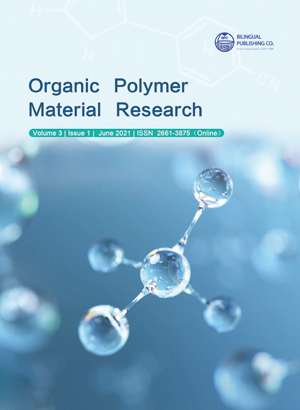-
267
-
235
-
165
-
159
-
138
Impact of Mixed Fillers on the Physico-mechanical Properties of Flexible Polyether Foam
DOI:
https://doi.org/10.30564/opmr.v3i1.3604Abstract
The effect of proportional blend of periwinkle and African star apple seed shell as bio-fillers in flexible polyether foam was studied. Flexible polyether foam samples incorporated with these bio-fillers at varying percentages; 10% (S1), 20% (S2), 30% (S3), 40% (S4) and 50% (S5) were produced respectively, while 0% (S0) which had no filler was used as control during the experiment. The mechanical properties of the produced foam samples were determined via density, compression set, indentation hardness, tensile strength and elongation at break tests. The cream time, rise time and height of the foam as parameters for characterising the produced foam samples were determined too. Flammability test was also carried out.The microstructure of the foam samples was analysed as well by using the scanning electron microscope. The results of the experiment showed that the density of the foam samples progressively increased from 19.20 (S0) – 26.45 (S5) as the quantity of the filler increased. The indentation hardness result also showed an increase on addition of the filler. The foam’s loading ability also increased on incorporation of the filler but S3 showed remarkable recovery after compression. The tensile strength and elongation at break of the foam decreased on addition of the filler. The morphological analysis ascertained the effect of the progressive introduction of the filler on the surface morphology of the foam. The flammability of the foam was found to decrease as the filler load increased. Since these fillers are of organic origin, readily available, cheap and eco-friendly, they provide a means of making biodegradable foam, and reducing the flammability of foam. Thus, reducing environmental pollution whilst enhancing the mechanical property of foam.Keywords:
Polyether foam; Periwinkle; African star apple seed shell; Mechanical properties; Scanning electron microscopyReferences
[1] Mills, J.N. (2007): Polyurethane Foam: Processing and Microstructure; Polymer Foams handbook, pp.19- 37.
[2] Oertel, G. and Abele, L. (1985): Polyurethane Handbook: Chemistry, Raw Materials, Processing, Application, Properties; Hanser Publishers, Distributed in USA by Scientific and Technical Books, Macmillan. Pp.1- 25.
[3] Billmeyer, F.W. (2005): Textbook of Polymer Science, 3rd edition, John wiley and sons, Toronto, p.447.
[4] Udhayasankar, R., Karthikeyan, B. (2015): A Review on Coconut Shell Reinforced Composites; International Journal of Chemistry And Technology Research,8(11):624-637.
[5] Onuegbu T.U., Obi J.N., Ejikeme C. (2010): The Effects of Palm kernel Powder as Filler in Flexible Polyether Foam; Journal of Physical Sciences, Ghana,2(4): 126-129.
[6] Babalola, F.U. and Dominic, E.(2012): A Comparative Ananlysis of the Effects of Calcium Carbonate and Dolomite as Fillers in Polyurethane Foam Product. Journal of Innovations in Science and Engineering,34-40.
[7] Raju G.U., Kumarappa S., Gaitonde V.N (2012): Mechanical and Physical Characterization of Agricultural Waste Reinforced Polymer Composites; Journal of Material and Environmental Sciences,3(5): 907- 916.
[8] Onuegbu T.U., Obianuko, N., Mbachu, G.U., and Iloamaeke, I.M., (2010), Effect of Animal Waste (Goat Femur) As Filler in Flexible Polyether Foam, Journal of Basic Physical Research, Vol 1(1):5-8.
[9] Toro P, Quijad R, Yazdani- Pedram M, and Arias J.L. (2007), Eggshell, a new bio-filler for polypropylene composites, Materials Letters, Vol. 61(22): 4347-4350.
[10] Chris-Okafor, P.U., Arinze, R. U., Nwokoye, J.N. and Umar, E. U. (2017); Effects of Coconut Husk and Corn Cob as Fillers in Flexible Polyurethane Foam. American Journal of Polymer Technology 3(4):64-69.
[11] Chris-Okafor, P.U., Arinze, R.U., Ekpunobi, U.E., and Anugwom, M.C. (2017); Effects of Mixed Rice Husk and Corn Cob as Fillers on Some Properties of Flexible Polyether Foam. Global Journal of Science Frontier Research: B Chemistry 17(2): 30-37.
[12] Manjunatha, G.H. andSabeel, A.K. (2017) : Experimental Characterization of Coconut Shell Particle Reinforced Epoxy Composites; Journal of Materials and Environmental Sciences,8(5): 1661- 1667.
[13] Nigerian Industrial Standard 53(1979): Method of Polyurethane Production.
[14] Saliba, C.C., Oréfice, R.L., Carneiro, J.R.G., Duarte, A.K, Schneider, W.T. and Fernandes, M.R.F. (2005); Effect of the incorporation of a novel natural inorganic short fiber on the properties of polyurethane composites. Polymer Test.; 24(7): 819-824.
[15] Samuel, E.A. , Ganiyu, K. L., Tinuade J. A. , Semiu A. K., (2015); Model Predictive Performance of Filled Flexible Polyurethane Foam. American Journal of Polymer Science; 5(1): 1-9.
[16] Onuegbu, T.U., Ugwu, I.E., Ogunfeyitimi, O. (2013): Physico- mechanical Properties of Flexible Polyether foam: Comparative Effects Of Fillers; Chemistry And Materials Research, 3:46-52.
[17] Dalen, M.B., Ibrahim, A.Q., Adamu, H.M., and Nurudeen, A.A., (2014), Effect of calcium carbonate and kaolin filler loading on curing rates of polyurethane foams, International research Journal of pure and applied chemistry; Vol. 4(6):691-694.
[18] Ruijun, G., Mohim, M.S. and Samir, K.K. (2013): A Feasible Study of Polyurethane Composites Foam with Added Hardwood Pulp, Industrial Crops and Products; Checkmate Press, New York,42(2):273-279.
[19] Javni, I., Song, K., Lin, J., Petrovic, Z. (2011): Struc-ture and Properties of Flexible Polyurethane Foams with Nano- and Micro- Fillers;Journal of Cellular Plastics,47(4):357-372.
[20] Agarry, S.E., Latinwo, G.K.,Afolabi,T.J., Kareen, A.S. (2015): Model Predictive Performance of Filled Flexible Polyurethane Foam; American Journal of Polymer Science, 5(1):1-9.
[21] Gharenbagh, A. and Ahmadi, Z. (2012): Polyurethane Flexible Foam Fire Behaviour, INTECH Open Access Publisher, Pp.1-10.
[22] Sant’Anna, S.S., Souza, D.A, Carvalho, C.F. and Yoshida, M.I. (2008): Morphological and Thermal Analyses of Flexible Polyurethane Foams Containing Commercial Calcium Carbonate; Ecletica, 33(2): 55-60.
[23] Agham, R.D. (2013): Performance of Coconut Husk Mixed Polyurethane Foam as an Alternative Insulating Material; International Journal of Engineering and Innovative Technology, 9(2): 100-104.




 Onwuka, C.O.
Onwuka, C.O.





